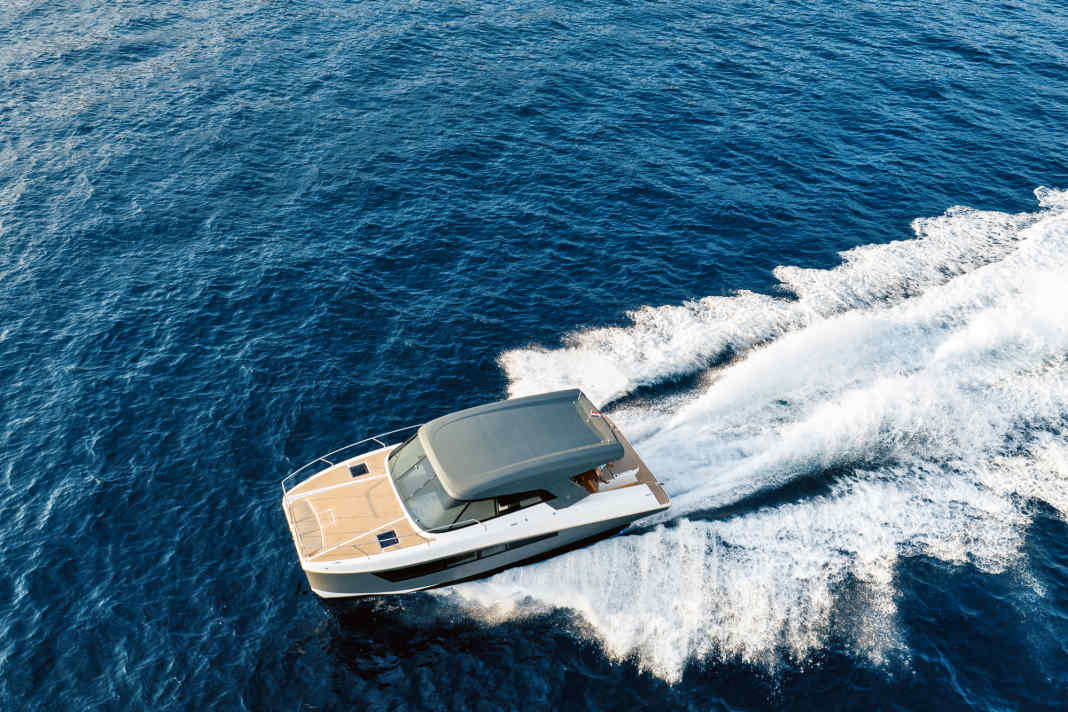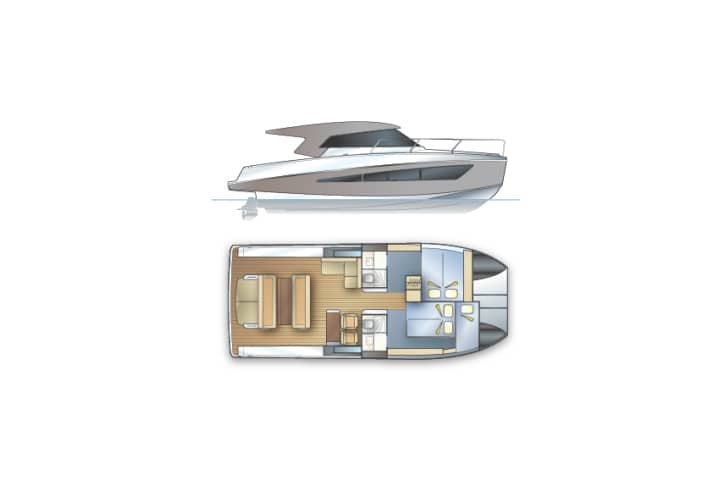





A whole 19 square metres of cockpit with two seating areas and a sun lounger for three people. Only a catamaran can offer this much space. The Makai M37 is such a boat, and yes, you read that right: 19 square metres of cockpit. Anyone who has ever looked for a room in a shared flat or a student flat will know that this much space is a luxury. But we don't want to talk about overpriced shared flats here. This report is about one of the most popular types of boat in recent years, the twin-hull boat. Catamarans have long been at the top of the charter sector, and they are also gaining ground in the owner sector.
But let's start with the background: At boot Düsseldorf 2024, three people suddenly stood at the Delius Klasing stand and wanted to present their project. During the conversation, it quickly became clear that we were dealing with people who knew what they wanted. At the end of July, the time had come for us to inspect and sail construction number 1 of the Makai M37 on the Adriatic off Split.
An experienced trio is behind the Makai
Makai is a young Croatian shipyard. One of the three founders, Jay Nolan, previously worked at various shipyards such as Chris-Craft or Monterey, so he comes from the industry and knows what is important. As does Kresimir Secak, who worked at Salona. Shane Grover, who is responsible for boatbuilding and previously worked for various shipyards, completes the trio.
The Italian sports car designer Emanuele Rossi initially designed the entire project as a 45-foot boat. However, this was too large for the first model, so it was quickly scaled down. The 33-foot version did not look good on the computer, so it became 37 feet. In the search for a suitable location, Italy was chosen. But the coronavirus pandemic forced a rethink. They now manufacture in Split, Croatia.
So you could say the brand is new, but the people behind it are not. Together, they can look back on well over 20 years of experience in boat building. And you notice that immediately.
How the shipyard in Split works
The boats are manufactured using a vacuum infusion process with polyester resin. The foam used is closed-cell PVC foam. During a short tour of the shipyard, we can get an idea of the work and the moulds. In the injection process, the dry reinforcing material is first inserted into the mould; in the case of the Makai, this is glass fibres in various types of fabric, such as Quadrax, i.e. quadruple-woven glass. The impregnation with resin only takes place after the mould has been closed by sucking the matrix (resin) into the mould using a vacuum. The opening of the resin supply from the resin container to the component is known as moulding.
Read also:
The vacuum infusion process offers many advantages, such as high quality, perfect surfaces on one side, high fibre content and cost-effective production of large components. As it requires little plant engineering, it is also a good option for small series, and the boat builders come into less contact with resin, which is also better for their health. However, the moulds need to be of a higher quality, as they must be absolutely vacuum-tight.
The layout of the Makai M37
After the tour of the shipyard, we head to the boat. The two-tone hull and the grey roof gleam in the sun. The teak-coloured plastic decking on the boat matches the hull visually and the upholstery is also beige. If you enter the boat via the stern, the first thing you see is a 1.85 x 1.50 metre sunbathing area. A fold-down backrest allows you to choose either the sunbathing area or a bench facing the 1.47 square metre cockpit table (0.70 x 2.10 metres). With a second bench, eight people can be comfortably seated here.
There is another seating area with table to port and a small galley to starboard. The raised steering position is also to starboard. The elevation provides a 360-degree all-round view, of course, but also creates a small area of its own for the helmsman. The helm station is equipped with two Raymarine plotters, two displays for the Yanmar engine data, buttons for various functions and, of course, a steering wheel, a throttle lever and a joystick system. A zipwake trim system, which can be found on almost all modern boats, is also installed. A small sliding window provides fresh air. About two metres further forward towards the bow is the access to the large foredeck with anchor locker.
The hulls of the cat
The hulls of many cats are designed differently. Usually one is the owner's hull and the other the guest hull. This is also the case with the Makai M37. The port hull is equipped with a 1.64 x 2.04 metre double bed and a one metre wide bathroom. There is plenty of space for clothes and there is also enough room to change in the cabin. Those lying in bed can see the most beautiful places in the world through the hull windows.
On the other side is the guest cabin with a smaller bed (1.40 x 2.00 metres) and another 80-centimetre-wide bed raised at the head of the first bed. There is considerably less space in the cabin, but still enough. There is also a large toilet here. Both are equipped with a shower, electric fresh water toilet, hot and cold water and a 60-litre faeces tank.
The test drive with the Makai M37
Before it gets too warm in the engine compartment after the test drive, let's take a look inside. The two Yanmar engines are properly connected, and the fuel filters, including the water separator, and all lines are installed according to regulations. Everything is in place and easy to reach for servicing. After taking a closer look at the boat, we leave the Lav marina. We have around 15 knots of wind on the water and between a quarter and half a metre of wave. The multihull slowly pounds against the waves. The soft immersion makes a positive impression.
If you accelerate further, the boat begins to glide at 2250 rpm and 14 knots and seems to float above the waves. It feels stiff and hardly twists at all. It also responds well and without delay to steering commands. As you would expect from a sporty Powercat, the hulls are designed to channel the air into a duct that tapers towards the rear, increasing pressure, generating lift and dampening the ride through the waves. The bridge deck is also slightly raised to minimise wave impact. This also increases the comfort and efficiency of the boat.
Over time, the waves get higher and we reach a peak of around 70 centimetres. Even this height is no problem for the cat. A little more sheltered in the bay of Split, we carry out our test manoeuvres and there is nothing to complain about. When cornering at over 20 knots, the boat reacts directly and smoothly. Turns can be made surprisingly tight. This is no problem even at higher speeds.
Good for a surprise
Many twin-hull boats have the problem that the spray from the shaft is diverted towards the deck when the boat is immersed in the shaft. This problem has been avoided here by design. Even at 28 knots top speed, the foredeck remains dry. Claudia Renz, who sells the Makai for Mittelmann's shipyard in Kappeln on the Schlei in Germany, was also surprised. It was also her first time on board.
The two Yanmar 8LV370 engines deliver good performance. They are connected to normal Z drives. With Q -SPD surface drives, the speed is to be increased to 38 knots in the GT version and 44 knots in the Open version.
Back in the marina, we are impressed. The Makai M37 handles perfectly and is fun to drive. She is predictable and controllable at all times. The Croatian catamaran is therefore also highly recommended for beginners.
Measurement results
Advantages
- + high-quality workmanship
- + Stable driving behaviour
- + Fender storage option
- + Plenty of storage space under the rear bench seat
Technical data

- CE category: B/12
- Length over everything: 11,40 m
- Width: 4,64 m
- Displacement: 9700 kg
- Draught (bottom drive): 0,55 m
- Water tank: 450 l
- Fuel tank: 900 l
- Max. motorisation: 2 x 370 hp (272 kW)
- Test motorisation: 2 x Yanmar 8LV with 370 hp each
- Price: from € 559,000 Sales
- Test boat: mittelmannswerft.de
Conclusion
The Makai M37 catamaran is a well-designed boat from a young shipyard. The experience of the founders is reflected in everything. The space on board is good for trips with family and friends. The quality of materials and workmanship is of a high standard.

